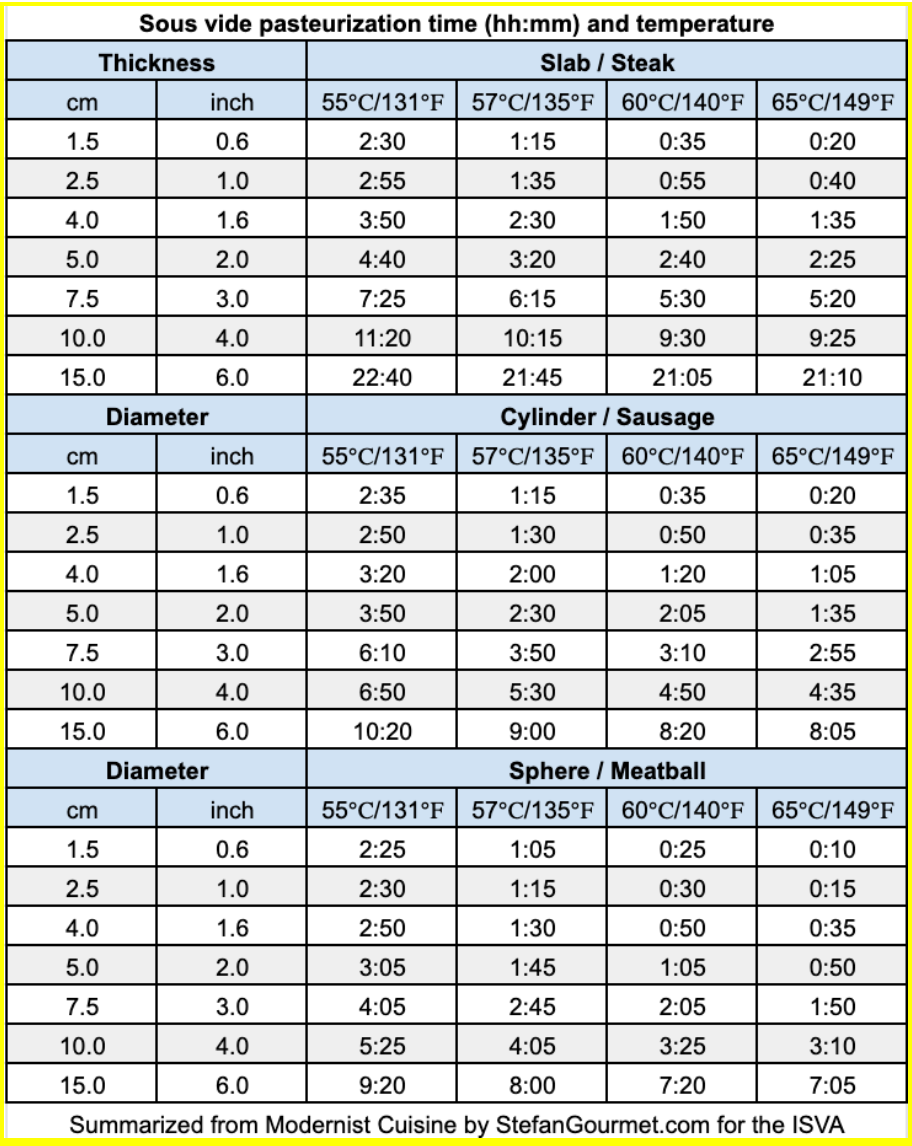Basic Sous Vide Food Safety
Sous vide is not inherently more dangerous or less dangerous in terms of food safety than other cooking methods, but there is one difference with most (high heat) cooking methods, and that is that more time is not always more safe. However if you follow the simple rules outlined below, sous vide cooking will be at least as safe as more conventional cooking methods. There are some safety margins in these rules, so breaking them is not necessarily unsafe. If you are an advanced sous vide user, look at the advanced sous vide food safety for more precise information.
All of the information in this article is based upon Modernist Cuisine, which in itself is based upon scientific research. The information is therefore more accurate than simplified ‘rules’ intended for the general public, which often err too much on the side of caution.
Disclaimer: ISVA cannot and does not substitute for legal or health advice about food regulations in any legal jurisdiction, nor can we guarantee that following the information presented by ISVA will prevent foodborne illness. Unfortunately, the many variables associated with food contamination make eliminating all risk and preventing all infections virtually impossible. We cannot accept responsibility for either health or legal problems that may result from following the advice presented by ISVA. If you operate a commercial establishment and serve food to the public, consult the rules and health regulations in your area.
It is important to follow food safety rules when cooking, because it is possible that microorganisms that can make you sick (such as bacteria) are present on or in the food you are preparing. Those microorganisms will grow as the temperature is in the so-called danger zone, which is between 5C/41F and 52C/125F. Food should not be in that zone for more than 4 hours cumulative. This includes time transporting the food home, preparing to cook, cooking, and cooling. The rules below use 54.5C/130F as the lowest safe temperature to cook at for longer than 3 hours to include safety margins for the time the food has spent transporting it home and preparing to cook, as well as the accuracy of the water temperature. For more exact information with fewer margins, CLICK HERE.
Always observe general food safety guidelines that apply to all kinds of cooking, like washing your hands before handling food, keeping your kitchen clean, watching out for cross-contamination (don’t let utensils or cutting boards that have been in contact with uncooked food also get in contact with cooked food), and storing uncooked proteins in the refrigerator at a temperature below 5C/41F.
To pack food for cooking sous-vide, only use food grade bags that are suitable for cooking.
Do not cook sous-vide at temperatures below 54.5C/130F for more than 3 hours.
Make sure the water has reached the cooking temperature before adding the food.
Steaks, chops, etc. from farmed beef, lamb or pork need only be cooked on the outside to at least 77C/170F. This can be done by searing the meat before or after cooking sous vide or by immersing the food after vacuum sealing in hot water of at least 77C/170F (boiling water is easiest as you don’t need a thermometer) until the raw color disappears completely (about 10-20 seconds).
Poultry, eggs, ground meat or meat that has in any other way been treated in such a way that microorganisms that were on the outside could have ended up on the inside (like injecting a marinade) need to be pasteurized before consuming. Pasteurization means heating the food such that most of the microorganisms that could be on or in the food have died. The thicker the food, the more time it will take. The lower the cooking temperature, the more time it will take. Use Table 1 below to find the correct thickness, time and temperature to achieve pasteurization. Using a longer time will make it more safe.
Fish and shellfish is cooked sous vide at temperatures that will not pasteurize it, as higher temperatures will ruin the fish. This means you should use fish that is so fresh you could eat it raw (for crustaceans and shellfish this usually means that it is still alive when you start cooking it), and that it is not a good idea to serve it to elderly people, infants, or pregnant women. It helps to immerse the seafood in hot water after vacuum sealing to kill any microorganisms on the outside, as explained in point 5 above. For inshore saltwater fish it is necessary to freeze the fish before consumption to eliminate parasites (anisakid nematodes).
If you cook food sous vide below 54.5C/130F, do not chill and reheat but consume it at once after cooking.
If the food has been cooked long enough to be pasteurized, it is safe to cool and reheat if it is cooled down to below 5C/41F within 2 hours. The food will cool off faster if the bag is put in cold water, even faster if there is also ice in the water. Using ice in the water is important if the food is thick, as otherwise it will take too long for the center to cool off. The time you can store chilled food after pasteurization depends on whether the food was actually vacuum sealed (instead of using a ziploc bag) and on the temperature of your refrigerator. Make sure your refrigerator is 5C/41F or colder, then you can store safely for 3 days. Longer if it is colder. When in doubt, freeze the food.
If reheating frozen food, reheat sous vide straight from the freezer, or allow to thaw in the refrigerator (not at room temperature) before reheating sous vide. For food safety there is no difference between those two methods.

